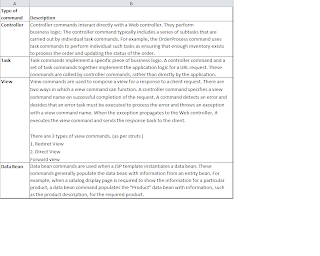Servelt Engine
The servlet engine is part of the WAS runtime environment that acts as a request dispatcher for inbound Uniform Resource Locator(URL) requests. The servelt engine manages a pool of threads to handle requests. each inbound request is executed on a separate thread.
Protocal listeners
Can invoke WC commands from various different devices.
1. Internet Browsers
2. Mobile phones using an Internet Browsers
3. B2B application sending XML messages using MQ
4. The WCS scheduler that executes commands and background jobs.
Protocal listener is a WAS rum-time component that receives inbound request from transports and then dispatches the requests to the appropriates adapters, based on the protocol used (request servlet, MQseries listener).
Adapters
WebSphere Commerce adapters are device-specific components that perform processing functions before passing a request to a controller.
1. Instructing the Web controller to process the request in a manner specific to the type of device. For example, a pervasive computing (PvC) device adapter can instruct the Web controller to ignore secure HTTP (HTTPS) checking in the original request.
2. Transforming the message format of the inbound request into a set of properties that WebSphere Commerce commands can understand.
3. Providing device-specific session persistence.
Web controller
A WC web controller is an application container that follows a design pattern similar to that of an EJB container. These containers simplify the role of commands, by providing such services as session management (based on the session persistence established by the adapter), transaction control, access control, and authentication.
The web controller also plays a role in enforcing the programming model for the commerce applicaion. ex: the programming model defines the types of commands that an application should write. each type of commands serves a specific purpose. Business logic must be implemented in controller commands.
Commands
WC commands are java beans that contains the programming logic associated with handling a particular request.
only Foward view command supported
Entity Beans
WC entity beans are the persistent, transactional commerce objects provided by WebSphere Commerce. These beans represent WebSphere Commerce data in an intuitive way. That is, rather than understanding the
database schema, you can access data from an entity bean that more closely models concepts and objects in the commerce domain. You may extend or replace existing entity beans.
Data Beans and Data bean commands
Data beans represent containers of properties (or data) that are primarily used by page designers. Most commonly, they provide a simple representation of a WebSphere Commerce entity.
A page designer can place these beans on a JSP template, allowing dynamic information to be populated on the page at display time. This person only needs to understand what data the bean can provide and what data the bean requires as input. In keeping with the theme of separating display from business logic, there is no need for the page designer to understand how the bean works.
Entity Beans
WC entity beans are the persistent, transactional commerce objects provided by WebSphere Commerce. These beans represent WebSphere Commerce data in an intuitive way. That is, rather than understanding the
database schema, you can access data from an entity bean that more closely models concepts and objects in the commerce domain. You may extend or replace existing entity beans.
Data Beans and Data bean commands
Data beans represent containers of properties (or data) that are primarily used by page designers. Most commonly, they provide a simple representation of a WebSphere Commerce entity.
A page designer can place these beans on a JSP template, allowing dynamic information to be populated on the page at display time. This person only needs to understand what data the bean can provide and what data the bean requires as input. In keeping with the theme of separating display from business logic, there is no need for the page designer to understand how the bean works.


No comments:
Post a Comment